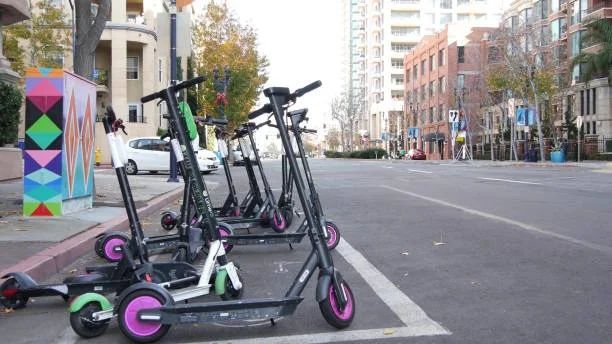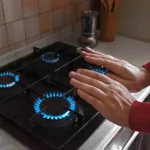It’s 5:42 p.m. Lights are flicking on across the block, a courier’s e-bike hums by with a pizza bag, two riders scoot past the bus stop, and a rideshare noses toward the curb like it’s docking at the ISS. That tiny sliver of evening, when the sky’s still blue but the roads feel shadowy, has become the new rush hour. Not just cars. Not just bikes. Scooters, delivery e-bikes, dog walkers, strollers, joggers, everyone.
Micromobility isn’t a trend anymore; it’s infrastructure. And the intersections we grew up with weren’t designed for this many modes moving this quickly. Good news: you don’t need a city plan to make your commute calmer. You need a few habits, a couple of cheap upgrades, and the right expectations at dusk.
The New Traffic Triangle
Emergency department data shows the surge is real: an estimated 448,600 micromobility-related injuries were treated nationwide from 2017–2023, including ~209,600 e-scooter ED visits in that span. CPSC also logged 193 e-bike fatalities over those years, with motor-vehicle conflicts and control issues among the top hazards.
The modern intersection works like a three-way pact: drivers scan for turn gaps while juggling door swings, vans that block sightlines, and late GPS pings; riders on e-bikes and scooters move faster than pedal-only cyclists and often carry loads that change braking and balance; and walkers step off curbs from behind parked SUVs, push strollers, and juggle a leash, a latte, and a podcast. Each group has literal and mental blind spots, so the real win isn’t arguing about right of way, but aboutr predictability. Ask yourself what you can do in the next ten seconds to make your path obvious to everyone else. In short: predictability beats priority, especially at dusk.
Plain-English Rules by Vehicle Type
E-Bikes
- Florida. Florida treats most e-bikes like bicycles statewide with the same rights and duties, while letting cities fine-tune where and how you ride (paths, sidewalks, share programs). No license, registration, or insurance required at the state level.
- California. Uses the three-class system (pedals, ≤750W motor). Class 3 (pedal-assist up to 28 mph) comes with a helmet rule; anyone under 18 must wear a helmet on any class. Local add-ons can apply.
- New York (state + NYC). NY recognizes e-bikes and lets them operate on many streets (typically ≤30-mph roads). Classes 1–2 are capped at 20 mph; Class 3 (up to 25 mph) is mainly an NYC thing, and the city layers extra rules and helmet requirements for certain riders. Sidewalks are generally off-limits unless your locality says otherwise.
- Colorado. Follows the electrical-assisted bicycle framework and generally gives riders the same rights and duties as other vehicle operators on the road; cities decide a lot about sidewalk and trail access.
- Connecticut (new rules phasing in Oct 1, 2025). Clarifies e-bikes as pedal-assist ≤750W and reclassifies higher-wattage machines as motor-driven cycles or motorcycles—think license/registration (and, for the motorcycle tier, insurance). Expanded helmet requirements are part of the update.
E-Scooters
- Florida. Stand-up scooters fall under “micromobility devices” with bicycle-like rights and duties; no state-level license/registration/insurance. Cities control the where/when (lanes, sidewalks, storm pauses for fleets).
- California. A “motorized scooter” (handlebars + floorboard) is capped at 15 mph; sidewalk riding is generally prohibited; riders under 18 need a helmet; and you need a driver’s license or permit (but not DMV registration).
- New York (state + NYC). Devices can be capable of 20 mph, but operational speed is limited to 15 mph; allowed on certain streets (usually ≤30-mph). Sidewalks are off-limits unless your locality allows it. Cities may add time/place/manner rules.
- Colorado. State law puts e-scooter users under the same general rights-and-duties umbrella as other vehicle operators, with lots of sidewalk/trail specifics left to local governments.
- Connecticut (trend). The 2025 safety package also touches scooters. Expect clearer lines between low-power devices and motor-driven cycles plus stricter helmet/operation rules as the updates roll in.
Do You Need Insurance?
Short answer: usually no for standard e-bikes (≤750W, three-class models) and stand-up e-scooters. You typically don’t register them like cars and most states don’t require a personal policy.
But your existing coverage may not fit: homeowners/renters often exclude motorized vehicles; auto usually doesn’t cover you while riding; health covers injuries, not property or your liability. Ask about bike/e-bike policies (theft, damage, liability) and consider Medical Payments/PIP on your auto policy for when you’re the rider who gets hit. If you’re using higher-power devices or doing deliveries, check local rules as some places treat those more like mopeds, which can trigger insurance requirements.
Etiquette That Prevents 90% of Near-Misses
For Drivers: Signal Early, Scan Low, Roll Slow
- Signal before you brake. Give riders and walkers that extra beat to read your trajectory.
- Eyes down for low profiles. Scooters and e-bikes sit lower than a car roofline; do a slow “L-scan” at every turn—mirrors → windshield → right/left corners.
- Door check like a pro. Before opening, pull the handle with your far hand so your shoulder turns and your eyes sweep the mirror and blind spot.
- Right-hook defense. Before turning right, re-check mirrors and the bike lane, then turn slow and tight.
- Left-turn patience. Yield to oncoming riders like you would to cars; small profiles arrive faster than they look.
- Clean glass = better night vision. Wipe the inside of your windshield; haze blooms glare at dusk.
- Park like a neighbor. Don’t nose into bike lanes or block sightlines near corners.
- Smart-car awareness. If your vehicle has driver-assist or connected features, learn what each alert means, and its limits.
For Riders: Be Seen, Be Heard, Be Predictable
- Choose your lane by speed. If you’re moving car-speed with traffic, claim the lane. If not, keep a steady line in the bike lane and avoid last-second swerves.
Talk with your hands. A simple hand signal and eye contact beat a thousand fancy lights. A bell tap is better than a “Sorry!” after. - Sidewalks? In dense corridors, slow to a jogger’s pace and yield like you’re the guest, because you are.
- Light + motion. Reflective ankle bands and a blinking rear light get noticed sooner than static patches.
- Queue like a car. Take your place in line at red lights; no last-second filter through turning lanes.
- Brake earlier with cargo. Loads change balance and stopping distance. Add a few bike-lengths.
- Ring before the pass. A bell tap from two bike-lengths back beats a shout at the elbow.
For Walkers: Make Moves Like a Crosswalk
- Square up. Step into the crosswalk facing the lane you’re crossing; avoid diagonal darts from between cars.
- Headphones rule of thumb. If you can’t hear your own footsteps or a bell tap, it’s too loud for street corners.
- Strollers and pups. Keep the stroller front wheels square to the curb and the leash short until you’re fully in the crosswalk.
- Pause at the parked-van edge. Peek past tall vehicles before stepping out; scooters sit below mirror height.
- Leashes short at corners. Keep pups and kids close until you’re fully in the crosswalk.
- One ear open. Drop to one earbud near intersections so you’ll catch bells and turn signals.
Fast forward to 6:07 p.m. The street’s still lively, but the rhythm’s different. Your signals came early, your lights flipped on before the sky went charcoal, and your line through the intersection was unmistakable. No horns. No side-eye. Just humans sharing a busy little stage and getting home with dinner still warm.
Shared streets feel better when everyone upgrades one or two habits. Start with visibility, add predictability, and the rest—gadgets, gear, even city design—starts working in your favor.







